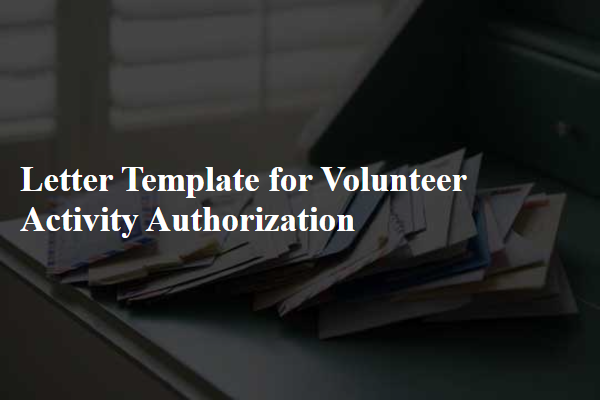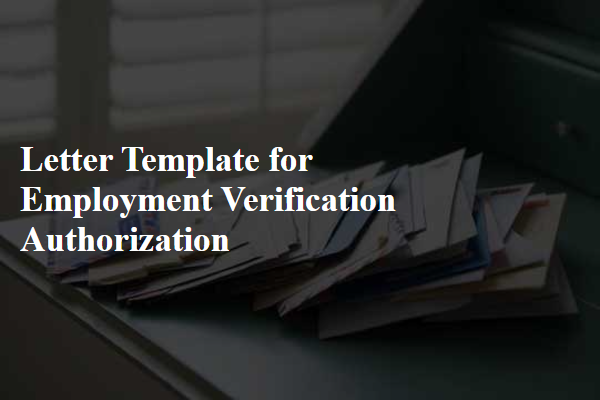Are you ready to make a difference in your community through volunteer activities? Whether you're helping out at local shelters, organizing events, or leading youth programs, having a proper authorization letter can help streamline your efforts and ensure everyone is on the same page. This simple yet important document not only provides clarity but also shows your commitment to the cause. So, let's dive into the essentials of crafting an effective volunteer activity authorization letter and get you started on your journey to making a positive impact!

Volunteer details (name, contact information)
A comprehensive volunteer authorization form typically includes essential elements such as the volunteer's full name, contact information (phone number, email address), emergency contact details, and relevant background information. This information ensures that the organization can reach the volunteer in case of emergencies or important updates. Additionally, details about the specific volunteer activity, including the event date, location (such as community centers or non-profit organizations), and tasks assigned can enhance clarity. A section for parental consent may be necessary for volunteers under a certain age. Finally, signatures from both the volunteer and the coordinating organization can formalize the agreement, ensuring understanding of responsibilities and expectations.
Description of activity and location
The volunteer activity entails participating in community clean-up efforts, specifically in Central Park, a prominent green space located in New York City. This initiative is scheduled for March 15, 2024, from 9 AM to 1 PM, aimed at collecting litter and enhancing the park's natural beauty to promote environmental awareness. Volunteers will gather at the park's main entrance on East 72nd Street, equipped with gloves, trash bags, and refreshments. Participation allows community members to engage in ecological stewardship while fostering camaraderie among volunteers. The activity holds significance as Central Park attracts approximately 42 million visitors annually, making its upkeep essential for promoting public health and environmental sustainability.
Date and duration of the activity
A volunteer activity authorization must include essential details for clarity and organization. The date and duration of the activity are crucial components. For instance, if the event occurs on November 15, 2023, commencing at 9:00 AM and concluding at 5:00 PM, it indicates a full day of commitment for volunteers. This specific timeframe allows volunteers to plan effectively, ensuring availability and preparedness for the tasks at hand. Details regarding the location, such as a community center, school, or park, can provide further context for the activity. Providing information on the type of volunteer work, whether it is a cleanup drive, food distribution, or community outreach, enriches understanding and encourages participation.
Liability and consent clauses
A volunteer activity authorization letter template includes essential liability and consent clauses, offering legal protection for organizations and volunteers. The liability clause explicitly outlines the responsibilities of both parties, ensuring that volunteers understand potential risks involved in their activities, such as physical injuries or property damage. Additionally, the consent clause requires volunteers to agree to the terms and conditions set forth by the organization, affirming their willingness to participate willingly and responsibly. This structure fosters a transparent environment, promoting safety and accountability while encouraging community involvement. Properly drafted, this template serves as a fundamental document, safeguarding interests and clarifying expectations.
Contact information of the authorizing organization
Volunteer organizations often require formal authorization for activities. The contact information of the authorizing organization typically includes key data such as the name of the organization, which identifies the entity responsible for overseeing volunteers. The address provides the physical location, often necessary for correspondence or administrative purposes. Phone numbers offer direct contact options, facilitating easy communication for various inquiries, clarifications, or emergencies. Email addresses enable rapid digital correspondence, essential for coordinating schedules, activities, and updates with volunteers. Important authorization details may also include official websites, which can provide additional context about the organization's mission, past projects, and volunteer opportunities.
Letter Template For Volunteer Activity Authorization Samples
Letter template of volunteer activity consent for school event participation

Letter template of volunteer activity permission for charity organization

Letter template of volunteer activity validation for outreach initiative

Letter template of volunteer activity acknowledgment for event organization

Letter template of volunteer activity authorization for internship program

Letter template of volunteer activity agreement for non-profit collaboration








Comments